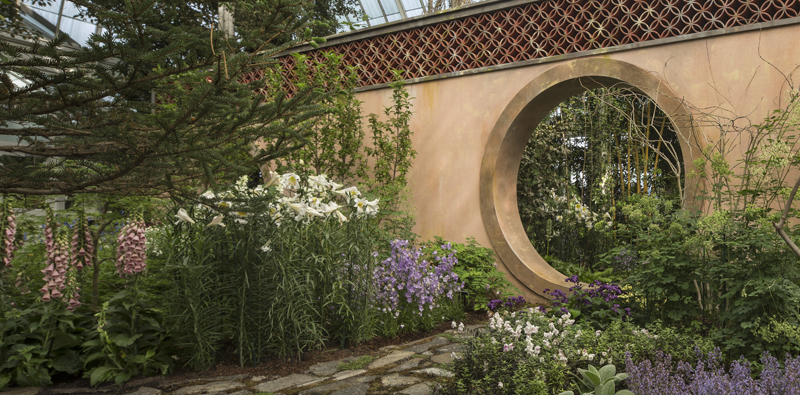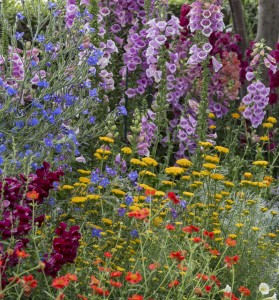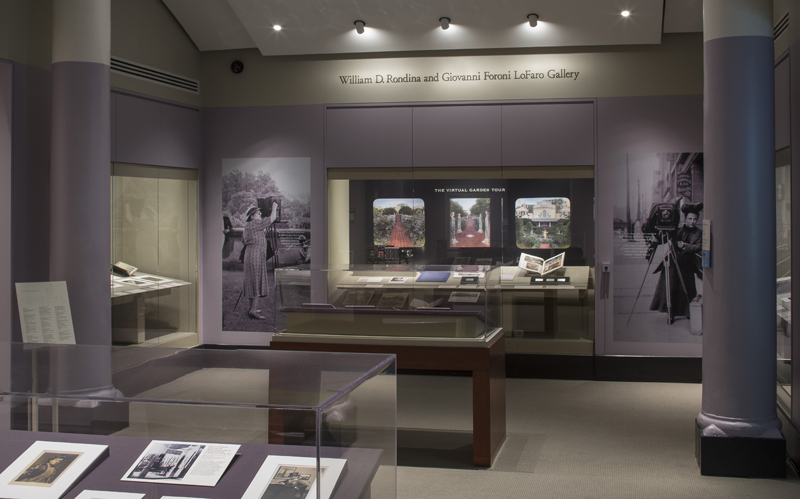Great American Gardens
Posted in Exhibitions on June 10 2014, by Sonia Uyterhoeven
Sonia Uyterhoeven is the NYBG’s Gardener for Public Education.

For the opening weekend of Groundbreakers: Great American Gardens and The Women Who Designed Them (May 17–September 7), curator Sam Watters led his audience back in time with a lecture entitled “Picturing a Beautiful America.” The show celebrates the work of some of America’s most influential women in early 20th century landscape architecture, design, and garden photography, and Watters’ talk set about laying the historical foundation on which these women and their works were established.
The figures highlighted in Groundbreakers were born in the 1860s and ’70s in a time when America was a largely rural society. In the subsequent decades, the topography of the American landscape changed dramatically. An industrial landscape soon emerged at the turn of the century, driven by the railroads, mining, and a growing immigrant labor force.
During this era, wealthy women banded together to form a movement that Watters succinctly labeled “Flowers and the Public Good.” They sought to instigate a cross-class revolution that would civilize and beautify America through gardening and other environmental initiatives. They were reacting to polluted rivers, the grime of urban life, and the rise of factories.
Proponents such as Edith Wharton wrote books on gardening and decorating with the aim of popularizing etiquette and “civilizing” the American populous through beautiful landscapes created for the social good. These advocates were trying to replace the filth of city life with a more pastoral sensibility.
 The Garden Club of America was founded in 1913 as part of this culture dedicated to the country’s beautification. The garden clubs were models of taste and refinement, and set about cleaning up railroad stations, parkways, and other prominent public spaces. They also hosted flower shows to raise money and awareness for their cause.
The Garden Club of America was founded in 1913 as part of this culture dedicated to the country’s beautification. The garden clubs were models of taste and refinement, and set about cleaning up railroad stations, parkways, and other prominent public spaces. They also hosted flower shows to raise money and awareness for their cause.
In 1921, the Boston Horticultural Society held a flower show that saw over 88,000 attendees in one month. A prominent feature of the show was a picturesque native landscape. Attendees were encouraged to take notes and copy lists of the plants so that they could recreate these showcase naturalistic settings back home. It was a lesson in exterior decorating.
Whether your garden was big or small, and whether you were rich or poor, the leading ladies of landscape architecture and design set specific ideals for all to aspire to. They publicized their work in magazines, bulletins, and through slide shows. The LuEsther T. Mertz Library Gallery features an exhibit of some of these photographic slides and the equipment used by three pioneer women photographers of the era.
Marian Coffin, Ellen Shipman, and Beatrix Farrand designed high profile gardens across the country for wealthy clients. In Coffin’s designs, the garden was intimately linked to the house as an outdoor extension of living space. Stately homes and palaces such as the Tuscan villas of the Medici family were models for her designs. Ellen Shipman stayed closer to home and looked back to Colonial America and gardens such as Mount Vernon for her inspiration. The cultural references for Abby Aldrich Rockefeller’s garden in Maine came from China, Korea, and England. Beatrix Farrand’s design paid tribute to several great moments in history.

For the leaders of the American landscape movement, beautiful gardens were an avenue to address some of the social and environmental woes that were associated with industrialization. They were emblems of refinement and models for the future.
Join us next week for the final lecture in a three-part series entitled Breaking Ground: American Women Landscape Pioneers (June 18th in the Ross Lecture Hall from 10-12 p.m.) and for a symposium on Women and the City: From a Landscape Perspective (June 20th in the Ross Lecture Hall from 9:30–12:30 p.m.). For more information on the lecture and symposium, see Adult Education.

